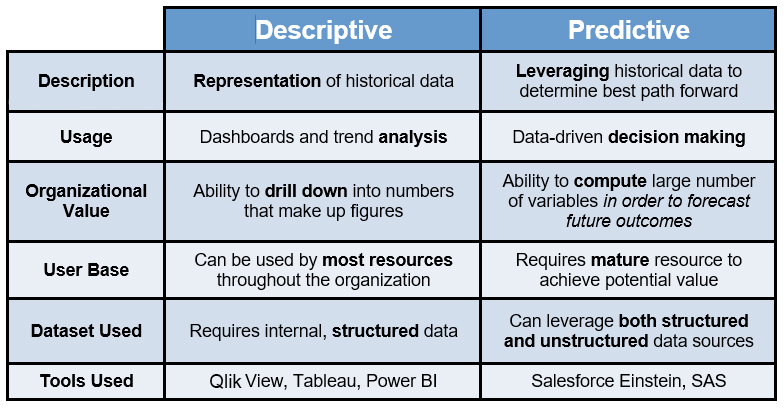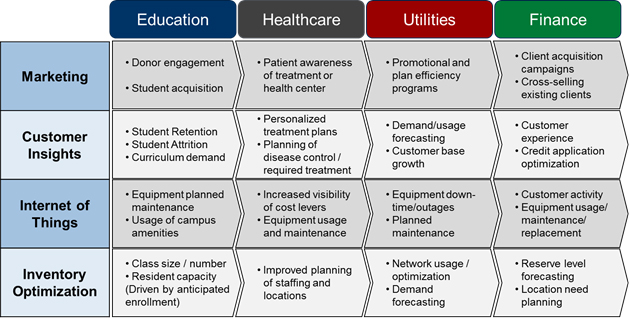Predictive Analytics Ain’t No Crystal Ball

I used to love going to Borders book stores. Going there on the weekends in the late 90’s was a great experience – between the wide variety of latest best sellers peppered throughout the store, and being able to put on the built-in headphones to listen to the most popular albums, you couldn’t help but enjoy your in-store experience. With the advent of online shopping, though, consumers’ tastes started to change. Borders, unfortunately, did not. Even with available data points, they failed to connect the dots and respond to changing consumer demands. By 2011, the company that had once had over 1,200 stores closed – gone the way of the Dodo. It’s quick to point the finger at management, but the company’s leaders weren’t inept; they simply failed to leverage their available information using business analytics – in particular, Predictive Analytics.
If your job title begins with a ‘C’, you know that effective use of data is the lifeblood of running any successful business and, in all likelihood, you have at least HEARD of Predictive Analytics. However, Predictive Analytics can be a nebulous concept – Can it actually predict the future? Is that what the Moneyball guy used? Should I use it in my organization? In case you don’t have time to read the rest of the article here are my answers – ‘Nope’, ‘Not really’, and the almighty ‘It depends’. However, this exponentially growing tool can (when used appropriately) revolutionize your organization, allowing you to make intelligent, strategic decisions based on an otherwise paralyzing mountain of data.
What is Predictive Analytics?
To better understand how it can catapult your organization forward, we first need to understand what Predictive Analytics is and, just as importantly, what it isn’t. Specifically, it’s important to differentiate Predictive Analytics from the more commonly used “descriptive” or “visual” analytics.
When you think of ‘Analytics’, images of fancy dashboards with all sorts of metrics and widgets tend to come to mind. These are the Descriptive Analytics in an organization. They provide very useful information that can be real-time and easily conveyed and understood throughout the entire organization. Usually this includes representing historical information, tracking progress against metrics, and drilling down into what makes up the numbers – you’ll notice that forward looking decision making doesn’t make this list.
Simply put, Predictive Analytics leverages the data available to an organization – some of which is used by Descriptive Analytics – and determines what data is actionable for your organization. However, it has to be used by a very mature user base with a narrow, specific focus to answer a specific question.

Descriptive versus Predictive Analytics
A great example of an effective employment of Predictive Analytics was done by Temple University in hopes of increasing retention and graduation rates. Despite an increase in Pell Grants and significant investments in student success programs like writing centers and career centers, the four year graduation and sophomore return rates were low. However, Temple had something on its side to combat this issue: data. Lots and lots of data.
Most sizeable educational institutions, Temple University included, have an incredible amount of information and statistics on their student body – GPA, educational background, socioeconomic profile, etc. Temple University leveraged this data and used predictive analytics to answer the simple question, “which students are most at risk of dropping out, and what can we do to prevent it”?
Conventional wisdom might lead you to think that the students most “at risk” of dropping out would be the same individuals that are most often considered “at risk” youths – students from lower income families with poor GPAs. However, using Predictive Analytics, Temple University discovered that their “at risk” population was very different than what conventional wisdom suggested, consisting primarily of students that were middle class (having fewer Pell Grants available) that worked off campus more than 15 hours per week.
With this new “target group” in mind, Temple was able to offer timely financial assistance to these individuals, with the condition of reducing their off-campus work during the school year. The results showed just how effective the Predictive Analytics was – sophomore return rates rose 12% and four year graduation rates rose 24% from 2001 to 2014.
Predictive Analytics is certainly not limited to Education, or even the public sector. Below are just a few examples of effective use cases for industries, but this could be extended out to any industry or organization that has data to be used and questions to be answered.

Uses of Predictive Analytics by Industry
What Can You Do?
Getting your organization into a position of effectively leveraging your own data is a process. However, there are steps you can take now to help get the process moving:
- Be honest with yourself on the current state of your organization’s data and data analysis – Are you comfortable with the integrity of your data? Does your data reliably allow you to make strategic decisions? If the answer is no, or if you aren’t sure, a more in-depth assessment might be needed. (This is fundamental to data analysis, so be sure to get this right!)
- Demand to have a data-driven mindset for critical decisions – To paraphrase a popular saying, opinions are like noses – everyone has one. What breeds confidence in the organization (and an increased chance of success) is using data as the foundation for hypotheses and recommendations when making impactful decisions.
- Explore tools to help you leverage your existing data – This does not suggest that you need to go out and by the latest and greatest tools. However, if your organization has enough data points that it is difficult to clearly see trends in Excel, or if you find yourself constantly struggling to find data to support your decisions, it might be time to invest in something for your organization.
Predictive Analytics is exciting. Organizations all over the world are realizing its benefits at an exponential rate, as more and more data becomes available through the Internet of Things, regular reporting, and a mobilized workforce. Be sure to put your data to work for you. When it comes to figuring out what options are in front of you, it’s better to use a flashlight than a crystal ball.
This is the initial article in a series on Predictive Analytics. We will continue to put out content on how you can better leverage your data to your advantage.
http://www.ewa.org/blog-higher-ed-beat/colleges-experiment-new-ways-graduating-more-students
Other articles in Strategic Transformation
Surviving the Business Transformation “Death Zone”
How Can a Job Title Help Your Business?
Embracing Uncertainty: The VUCA Principle
Mature Innovation
